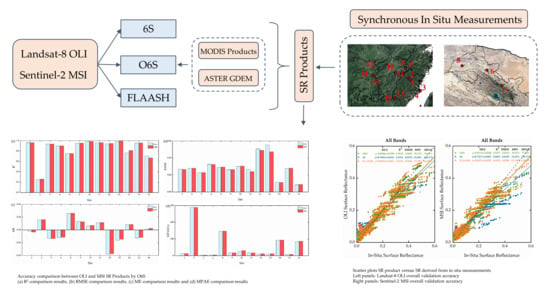Evaluation of Surface Reflectance Products Based on Optimized 6S Model Using Synchronous In Situ Measurements
Abstract
:1. Introduction
2. Data
2.1. In Situ Measurements
- (1)
- Place the white board around the sample and make sure that the white board is in the same level position as the sample surface. The operator faces the sun and makes the optical fiber is aligned vertically with the white board to determine the optical fiber sampling height.
- (2)
- Optimize the Spectroradiometer. Re-optimize every 15–20 min or when lighting conditions and environmental conditions change significantly. Each time the target is changed, the spectroradiometer is re-optimized.
- (3)
- After the optimization, the optical fiber is still vertically aligned with the whiteboard, and the DN value of reflected light is collected. Then the DN value of the sample will be collected and compared with the average DN value of the whiteboard, and the reflectance of the sample is calculated.
- (4)
- The optical fiber aims at the sample and makes the relative reflectance curve of the sample display stably on the interface.
- (5)
- The current spectral curve is stored. Five radiance spectra curves as a group are collected for each point, and dozens or even hundreds of groups of data are collected for each site. These results are then averaged (after manual removal of spurious spectra) by ViewSpecPro software to retain the optimal spectral curve and achieve a representative radiance spectrum.
- (6)
- The native spectral resolution across the full range (i.e., 3 nm in the VNIR and 8 nm in the SWIR) is internally resampled to 1 nm for the output spectra.
- (1)
- Fujian: Rice at heading stage and water in Nanping; sand beach and water in Pingtan.
- (2)
- Gansu: Two Gobi Desert sites in Dunhuang and Jiayuguan; wheat in Zhangye.
- (3)
- Jiangxi: River water, mature rice in Shangrao; rice at heading stage and mature rice in Fuzhou.
- (4)
- Hunan: Rice stubble, grass, and Xiangjiang river in Zhuzhou.
- (5)
- Guangdong: Mature rice and lake water in Meizhou.
2.2. Landsat-8 OLI and Sentinel-2 MSI
2.3. Auxiliary Data
3. Methods
3.1. Categorical Boosting(CatBoost)
3.2. Optimized Second Simulation of the Satellite Signal in the Solar Spectrum (O6S)
- (1)
- Convert the projection of MODIS atmospheric products (MDO04, MOD05, and MOD07) by HEG software.
- (2)
- The invalid values of the MODIS atmospheric products obtained in step (1) are reconstructed by the CatBoost (MOD04 AOD values at 550 nm) and Kriging (MOD05 water vapor products and MOD07 total ozone products) method.
- (3)
- Use the reconstructed MODIS atmospheric products, DEM, and other input parameters, the 6S model calculates atmospheric correction parameters.
- (4)
- Convert projection and resampling to make its projection and resolution consistent with Landsat-8 OLI and Sentinel-2 MSI data.
- (5)
- Finally, the surface reflectance image is calculated according to Formula (2).
3.3. Comparison Methodology
3.3.1. Method of Least Squares (MLS)
3.3.2. Root Mean Square Error (RMSE)
3.3.3. Mean Error (ME), Mean Percent Error (MPE), and Mean Percent Absolute Error (MPAE)
4. Results
4.1. Validation and Evaluation Results of Two Sensors
4.1.1. Landsat-8 OLI SR Validation and Evaluation Results
4.1.2. Sentinel-2 MSI SR Validation and Evaluation Results
4.2. Accuracy Comparison of Two Kinds of Reflectance Products
4.3. Accuracy Comparison between Direct and Indirect Validation
5. Discussion
5.1. Accuracy Evaluation of Each Band
5.2. Accuracy Evaluation of Different Cover Types
5.3. Accuracy Comparison of Different Data
5.4. Limitation and Future Perspectives
6. Conclusions
Author Contributions
Funding
Data Availability Statement
Acknowledgments
Conflicts of Interest
References
- Nazeer, M.; Wong, M.S.; Nichol, J.E. A new approach for the estimation of phytoplankton cell counts associated with algal blooms. Sci. Total Environ. 2017, 590–591, 125–138. [Google Scholar] [CrossRef] [PubMed]
- Nazeer, M.; Ilori, C.O.; Bilal, M.; Nichol, J.E.; Wu, W.; Qiu, Z.; Gayene, B.K. Evaluation of atmospheric correction methods for low to high resolutions satellite remote sensing data. Atmos. Res. 2021, 249, 105308. [Google Scholar] [CrossRef]
- Vermote, E.F.; Tanré, D.; Deuze, J.L.; Herman, M.; Morcette, J.J. Second simulation of the satellite signal in the solar spectrum, 6S: An overview. IEEE Trans. Geosci. Remote. Sens. 1997, 35, 675–686. [Google Scholar] [CrossRef] [Green Version]
- Wu, X.; Wen, J.; Xiao, Q.; Yu, Y.; You, D.; Hueni, A. Assessment of NPP VIIRS Albedo Over Heterogeneous Crop Land in Northern China. J. Geophys. Res. Atmos. 2017, 122, 113–138. [Google Scholar] [CrossRef] [Green Version]
- Yumimoto, K.; Nagao, T.M.; Kikuchi, M.; Sekiyama, T.T.; Murakami, H.; Tanaka, T.Y.; Ogi, A.; Irie, H.; Khatri, P.; Okumura, H.; et al. Aerosol data assimilation using data from Himawari-8, a next-generation geostationary meteorological satellite. Geophys. Res. Lett. 2016, 43, 5886–5894. [Google Scholar] [CrossRef]
- Zhang, H.; Kondragunta, S.; Laszlo, I.; Liu, H.; Remer, L.A.; Huang, J.; Superczynski, S.; Ciren, P. An enhanced VIIRS aerosol optical thickness (AOT) retrieval algorithm over land using a global surface reflectance ratio database. J. Geophys. Res. Atmos. 2016, 121, 10717–10738. [Google Scholar] [CrossRef]
- Giannis, L.; Zina, M.; Nektarios, C. Comparison of physically and image based atmospheric correction methods for Sentinel-2 satellite imagery. In Proceedings of the Fourth International Conference on Remote Sensing and Geoinformation of the Environment (RSCy2016), Paphos, Cyprus, 4–8 April 2016. [Google Scholar]
- Eric, V.; Chris, J.; Martin, C.; Belen, F. Preliminary analysis of the performance of the Landsat 8/OLI land surface reflectance product. Remote Sens. Environ. 2016, 185, 46–56. [Google Scholar]
- Wang, Y.; Liu, L.; Hu, Y.; Li, D.; Li, Z. Development and validation of the Landsat-8 surface reflectance products using a MODIS-based per-pixel atmospheric correction method. Int. J. Remote Sens. 2016, 37, 1291–1314. [Google Scholar] [CrossRef]
- Neil, F.; Clement, A.; Prasad, S.T. Comparing Sentinel-2A and Landsat 7 and 8 Using Surface Reflectance over Australia. Remote Sens. 2017, 9, 659. [Google Scholar]
- Muhammad, B.; Majid, N.; Janet, E.N.; Max, P.B.; Qiu, Z.; Evelyn, J.; James, R.C.; Luqman, A.; Huang, X.; Simone, L. A Simplified and Robust Surface Reflectance Estimation Method (SREM) for Use over Diverse Land Surfaces Using Multi-Sensor Data. Remote Sens. 2019, 11, 1134. [Google Scholar]
- Lee, K.S.; Lee, C.S.; Seo, M.; Choi, S.; Seong, N.H.; Jin, D.; Yeom, J.-M.; Han, K.-S. Improvements of 6S Look-Up-Table Based Surface Reflectance Employing Minimum Curvature Surface Method. Asia-Pac. J. Atmos. Sci. 2020, 56, 235–248. [Google Scholar] [CrossRef] [Green Version]
- Min, F.; Chengquan, H.; Saurabh, C.; Eric, F.V.; Jeffrey, G.M.; John, R.T. Quality assessment of Landsat surface reflectance products using MODIS data. Comput. Geosci.-UK 2012, 38, 9–22. [Google Scholar]
- Francesco, V.; Matteo, M.; Clement, A. Comparison of the Landsat Surface Reflectance Climate Data Record (CDR) and manually atmospherically corrected data in a semi-arid European study area. Int. J. Appl. Earth Obs. Geoinf. 2015, 42, 1–10. [Google Scholar]
- Nazeer, M.; Nichol, J.E.; Yung, Y.K. Evaluation of atmospheric correction models and Landsat surface reflectance product in an urban coastal environment. Int. J. Remote Sens. 2014, 35, 6271–6291. [Google Scholar] [CrossRef]
- Maiersperger, T.K.; Scaramuzza, P.L.; Leigh, L.; Shrestha, S.; Gallo, K.P.; Jenkerson, C.B.; Dwyer, J.L. Characterizing LEDAPS surface reflectance products by comparisons with AERONET, field spectrometer, and MODIS data. Remote Sens. Environ. 2013, 136, 1–13. [Google Scholar] [CrossRef] [Green Version]
- Claverie, M.; Vermote, E.F.; Franch, B.; Masek, J.G. Evaluation of the Landsat-5 TM and Landsat-7 ETM + surface reflectance products. Remote Sens. Environ. 2015, 169, 390–403. [Google Scholar] [CrossRef]
- Moe, B.; Dennis, H.; Larry, L.; Xin, J. Methods for Earth-Observing Satellite Surface Reflectance Validation. Remote Sens. 2019, 11, 1543. [Google Scholar]
- Cibele, T.P.; Xin, J.; Larry, L. Evaluation Analysis of Landsat Level-1 and Level-2 Data Products Using In Situ Measurements. Remote Sens. 2020, 12, 2597. [Google Scholar]
- Song, C.; Woodcock, C.E.; Seto, K.C.; Lenney, M.P.; Macomber, S.A. Classification and Change Detection Using Landsat TM Data: When and How to Correct Atmospheric Effects? Remote Sens. Environ. 2001, 75, 230–244. [Google Scholar] [CrossRef]
- Min, F.; Joseph, O.S.; Huang, C.; Jeffrey, G.M.; Eric, F.V.; Feng, G.; Raghuram, N.; Saurabh, C.; Robert, E.W.; John, R.T. Global surface reflectance products from Landsat: Assessment using coincident MODIS observations. Remote Sens. Environ. 2013, 134, 276–293. [Google Scholar]
- James, R.I.; John, L.D.; Julia, A.B. The next Landsat satellite: The Landsat Data Continuity Mission. Remote Sens. Environ. 2012, 122, 11–21. [Google Scholar]
- Drusch, M.; Del Bello, U.; Carlier, S.; Colin, O.; Fernandez, V.; Gascon, F.; Hoersch, B.; Isola, C.; Laberinti, P.; Martimort, P.; et al. Sentinel-2: ESA’s Optical High-Resolution Mission for GMES Operational Services. Remote Sens. Environ. 2012, 120, 25–36. [Google Scholar] [CrossRef]
- Jian, L.; David, P.R.; Clement, A.; Guoqing, Z. A Global Analysis of Sentinel-2A, Sentinel-2B and Landsat-8 Data Revisit Intervals and Implications for Terrestrial Monitoring. Remote Sens. 2017, 9, 902. [Google Scholar]
- Homer, C.; Huang, C.; Yang, L.; Wylie, B.; Coan, M. Development of a 2001 National Land-Cover Database for the United States. Photogramm. Eng. Remote Sens. 2004, 70, 829–840. [Google Scholar] [CrossRef] [Green Version]
- Kaufman, Y.J. Algorithm for Remote Sensing of Tropospheric Aerosol from Modis. In NASA MODIS Algorithm Theoretical Basis Document; Goddard Space Flight Center: Greenbelt, MD, USA, 1998. [Google Scholar]
- King, M.D.; Tsay, S.C.; Platnick, S.E.; Wang, M.; Liou, K.N. Cloud Retrieval Algorithms for MODIS: Optical Thickness, Effective Particle Radius, and Thermodynamic Phase, MODIS Algorithm Theoretical Basis Document; Cambridge University Press: Greenbelt, MD, USA, 1997. [Google Scholar]
- Seemann, S.W.; Borbas, E.E.; Li, J.; Menzel, W.P.; Gumley, L.E. MODIS Atmospheric Profile Retrieval Algorithm Theoretical Basis Document; Cooperative Institute for Meteorological Satellite Studies, University of Wisconsin-Madison: Madison, WI, USA, 2006; p. 40. [Google Scholar]
- Chen, X.; Xing, J.; Liu, L.; Li, Z.; Mei, X.; Fu, Q.; Xie, Y.; Ge, B.; Li, K.; Xu, H. In-Flight Calibration of GF-1/WFV Visible Channels Using Rayleigh Scattering. Remote Sens. 2017, 9, 513. [Google Scholar] [CrossRef] [Green Version]
- Pandya, M.R.; Pathak, V.N.; Shah, D.B.; Singh, R.P. Retrieval of Surface Reflectance using SACRS2: A Scheme for Atmospheric Correction of ResourceSat-2 AWiFS data. ISPRS-Int. Arch. Photogramm. Remote Sens. Spat. Inf. Sci. 2014, XL-8, 865–868. [Google Scholar] [CrossRef] [Green Version]
- Sun, Z.; Wei, J.; Zhang, N.; He, Y.; Sun, Y.; Liu, X.; Yu, H.; Sun, L. Retrieving High-Resolution Aerosol Optical Depth from GF-4 PMS Imagery in Eastern China. Remote Sens. 2021, 13, 3752. [Google Scholar] [CrossRef]
- Prokhorenkova, L.; Gusev, G.; Vorobev, A.; Dorogush, A.V.; Gulin, A. CatBoost: Unbiased boosting with categorical features. In Proceedings of the Advances in Neural Information Processing Systems 31 (NeurIPS 2018), Montréal, QC, Canada, 3–8 December 2018. [Google Scholar]
- Chair-Krishnapuram, B.G.; Chair-Shah, M.G.; Chair-Smola, A.P.; Chair-Aggarwal, C.P.; Chair-Shen, D.P.; Chair-Rastogi, R.P. Acm Sigkdd International Conference on Knowledge Discovery & Data Mining. In Proceedings of the 22nd ACM SIGKDD International Conference on Knowledge Discovery and Data Mining, San Francisco, CA, USA, 13–17 August 2016. [Google Scholar]
- Zhang, Y.; Zhao, Z.; Zheng, J. CatBoost: A new approach for estimating daily reference crop evapotranspiration in arid and semi-arid regions of Northern China. J. Hydrol. 2020, 588, 125087. [Google Scholar] [CrossRef]
- Dorogush, A.V.; Ershov, V.; Gulin, A. CatBoost: Gradient boosting with categorical features support. arXiv 2018, arXiv:1810.11363. [Google Scholar]
- Hancock, J.; Khoshgoftaar, T.M. CatBoost for Big Data: An Interdisciplinary Review. J. Big Data 2020, 7, 94. [Google Scholar] [CrossRef] [PubMed]
- Khalid, R.; Javaid, N. A Survey on Hyperparameters Optimization Algorithms of Forecasting Models in Smart Grid. Sustain. Cities Soc. 2020, 61, 102275. [Google Scholar] [CrossRef]
- Ding, Y.; Chen, Z.; Lu, W.; Wang, X. A CatBoost approach with wavelet decomposition to improve satellite-derived high-resolution PM2.5 estimates in Beijing-Tianjin-Hebei. Atmos. Environ. 2021, 249, 118212. [Google Scholar] [CrossRef]
- Xue, C.; Chen, S.; Lee, Z.; Hu, L.; Shi, X.; Lin, M.; Liu, J.; Ma, C.; Song, Q.; Zhang, T. Iterative near-infrared atmospheric correction scheme for global coastal waters. ISPRS J. Photogramm. 2021, 179, 92–107. [Google Scholar] [CrossRef]
- Juan, C.J.; José, A.S.; Cristian, M.; Belen, F. Atmospheric correction of optical imagery from MODIS and Reanalysis atmospheric products. Remote Sens. Environ. 2010, 114, 2195–2210. [Google Scholar]
- Kotchenova, S.Y.; Vermote, E.F.; Matarrese, R.; Klemm, F.J. Validation of a vector version of the 6S radiative transfer code for atmospheric correction of satellite data. Part I: Path radiance. Appl. Opt. 2006, 45, 6762–6774. [Google Scholar] [CrossRef] [Green Version]
- Ron, M.; Julia, B.; Raviv, L.; Brian, M.; Esad, M.; Lawrence, O.; Pat, S.; Kelly, V. Landsat-8 Operational Land Imager (OLI) Radiometric Performance On-Orbit. Remote Sens. 2015, 7, 2208–2237. [Google Scholar]
- Miura, T.; Huete, A.R.; Yoshioka, H. Evaluation of sensor calibration uncertainties on vegetation indices for MODIS. IEEE Trans. Geosci. Remote Sens. 2000, 38, 1399–1409. [Google Scholar] [CrossRef]
- Dennis, H.; Kurt, T.; Dave, A.; Larry, L.; Jeff, C.; Nathan, L.; Stuart, B.; Nik, A. Recent surface reflectance measurement campaigns with emphasis on best practices, SI traceability and uncertainty estimation. Metrologia 2012, 49, 21–28. [Google Scholar]
- Junchang, J.; David, P.R.; Eric, V.; Jeffrey, M.; Valeriy, K. Continental-scale validation of MODIS-based and LEDAPS Landsat ETM+ atmospheric correction methods. Remote Sens. Environ. 2012, 122, 175–184. [Google Scholar]
- Georgia, D.; Eric, V.; Jean-Claude, R.; Ferran, G.; Stefan, A.; David, F.; Olivier, H.; André, H.; Grit, K.; Fuqin, L.; et al. Atmospheric Correction Inter-Comparison Exercise. Remote Sens. 2018, 10, 352. [Google Scholar]
- Rasmus, H.; Matthew, F.M. Impacts of dust aerosol and adjacency effects on the accuracy of Landsat 8 and RapidEye surface reflectances. Remote Sens. Environ. 2017, 194, 127–145. [Google Scholar]
- Zhang, H.K.; Roy, D.P.; Yan, L.; Li, Z.; Huang, H.; Vermote, E.; Skakun, S.; Roger, J.-C. Characterization of Sentinel-2A and Landsat-8 top of atmosphere, surface, and nadir BRDF adjusted reflectance and NDVI differences. Remote Sens. Environ. 2018, 215, 482–494. [Google Scholar] [CrossRef]
- Martin, C.; Junchang, J.; Jeffrey, G.M.; Jennifer, L.D.; Eric, F.V.; Jean-Claude, R.; Sergii, V.S.; Christopher, J. The Harmonized Landsat and Sentinel-2 surface reflectance data set. Remote Sens. Environ. 2018, 219, 145–161. [Google Scholar]
- David, F.; Marion, S.; Patrick, H. A Global MODIS Water Vapor Database for the Operational Atmospheric Correction of Historic and Recent Landsat Imagery. Remote Sens. 2019, 11, 257. [Google Scholar]
- Feng, L.; Hou, X.; Li, J.; Zheng, Y. Exploring the potential of Rayleigh-corrected reflectance in coastal and inland water applications: A simple aerosol correction method and its merits. ISPRS J. Photogramm. 2018, 146, 52–64. [Google Scholar] [CrossRef]
- Tuomiranta, A.; Alet, P.; Ballif, C.; Ghedira, H. Worldwide performance evaluation of ground surface reflectance models. Sol. Energy. 2021, 224, 1063–1078. [Google Scholar] [CrossRef]
- Niall, O.; Javier, G.; James, R.; Joanne, N.; Agnieszka, B. Fiducial Reference Measurements for validation of Sentinel-2 and Proba-V surface reflectance products. Remote Sens. Environ. 2020, 241, 111690. [Google Scholar]

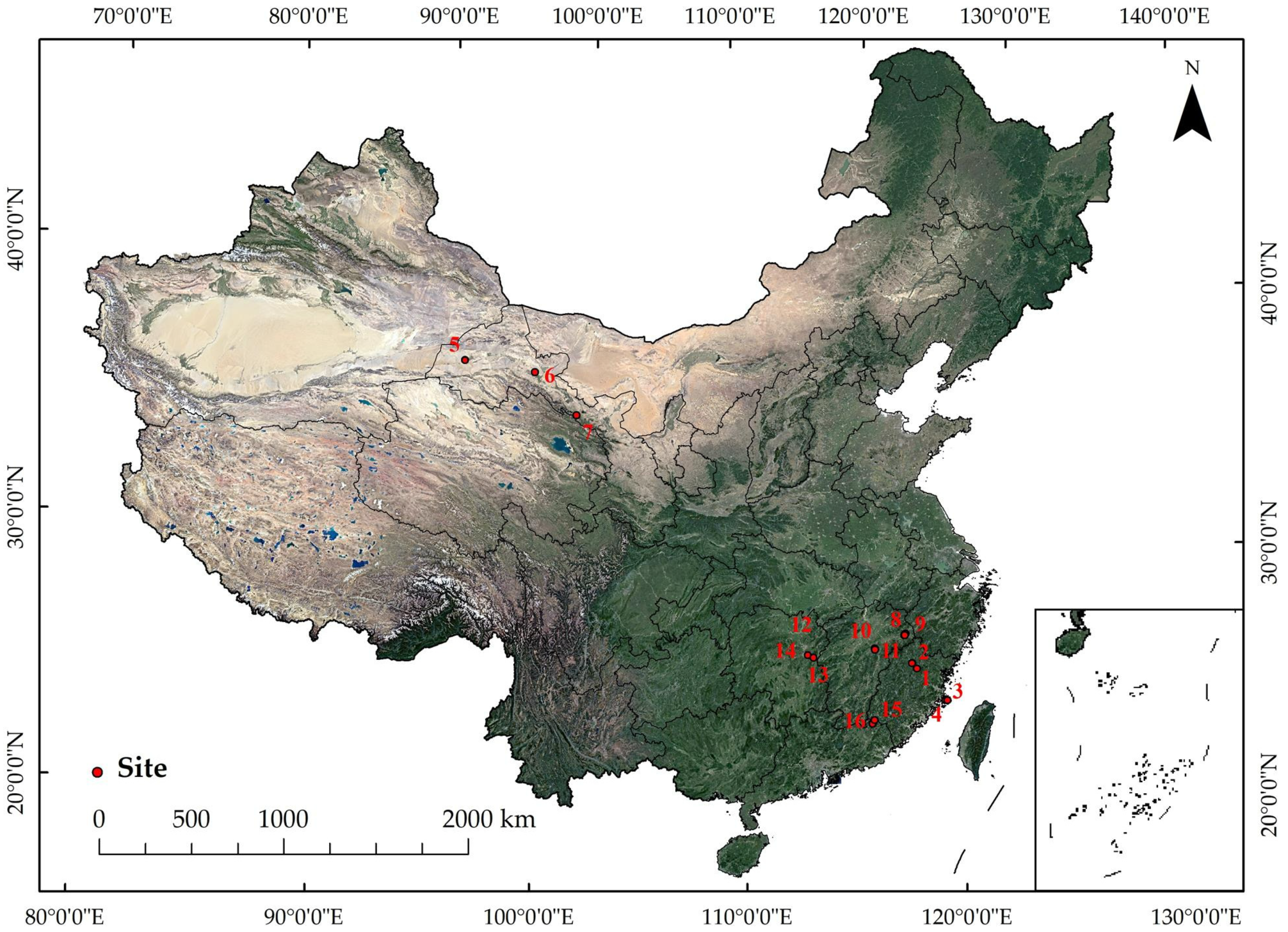

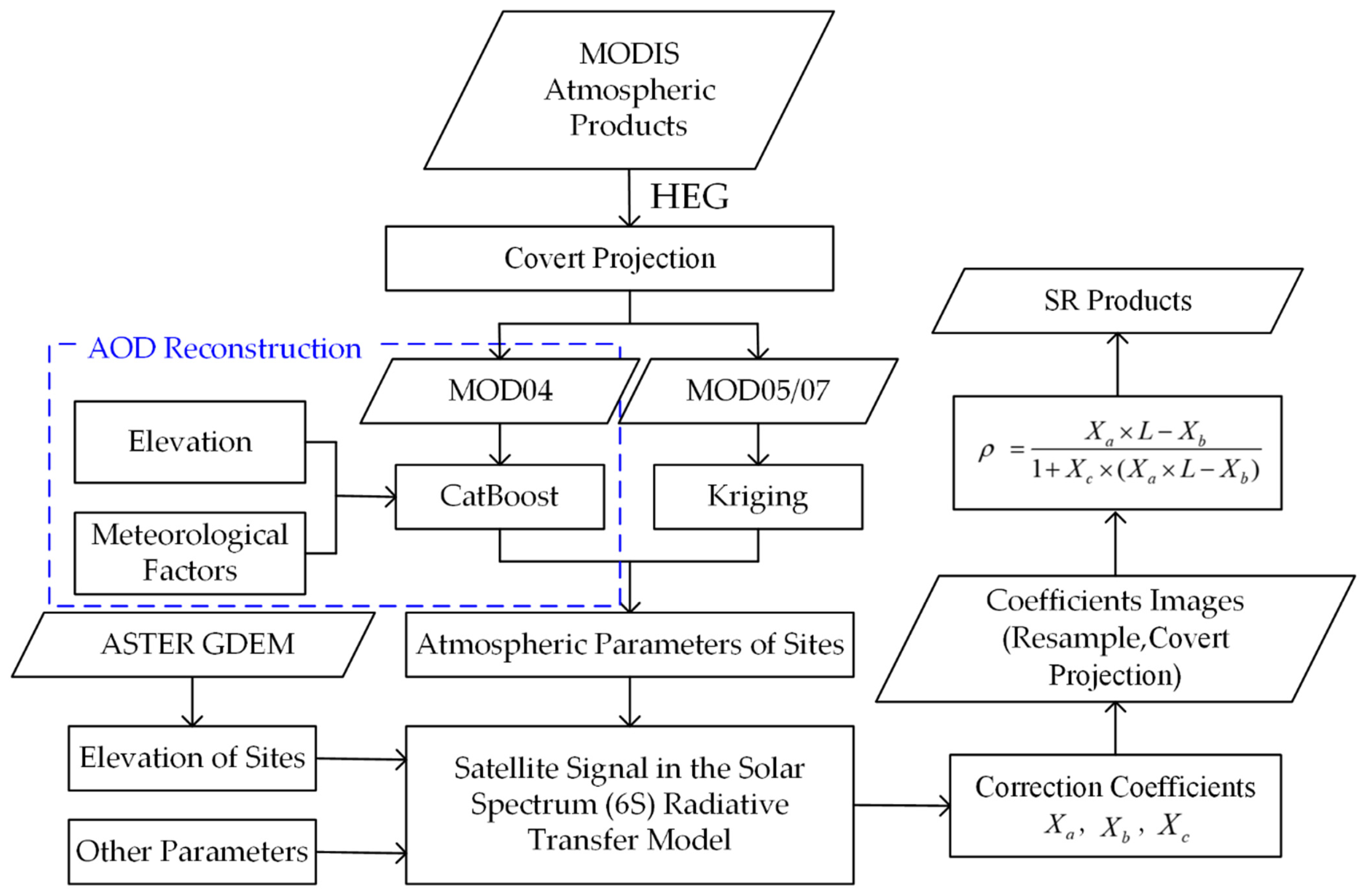


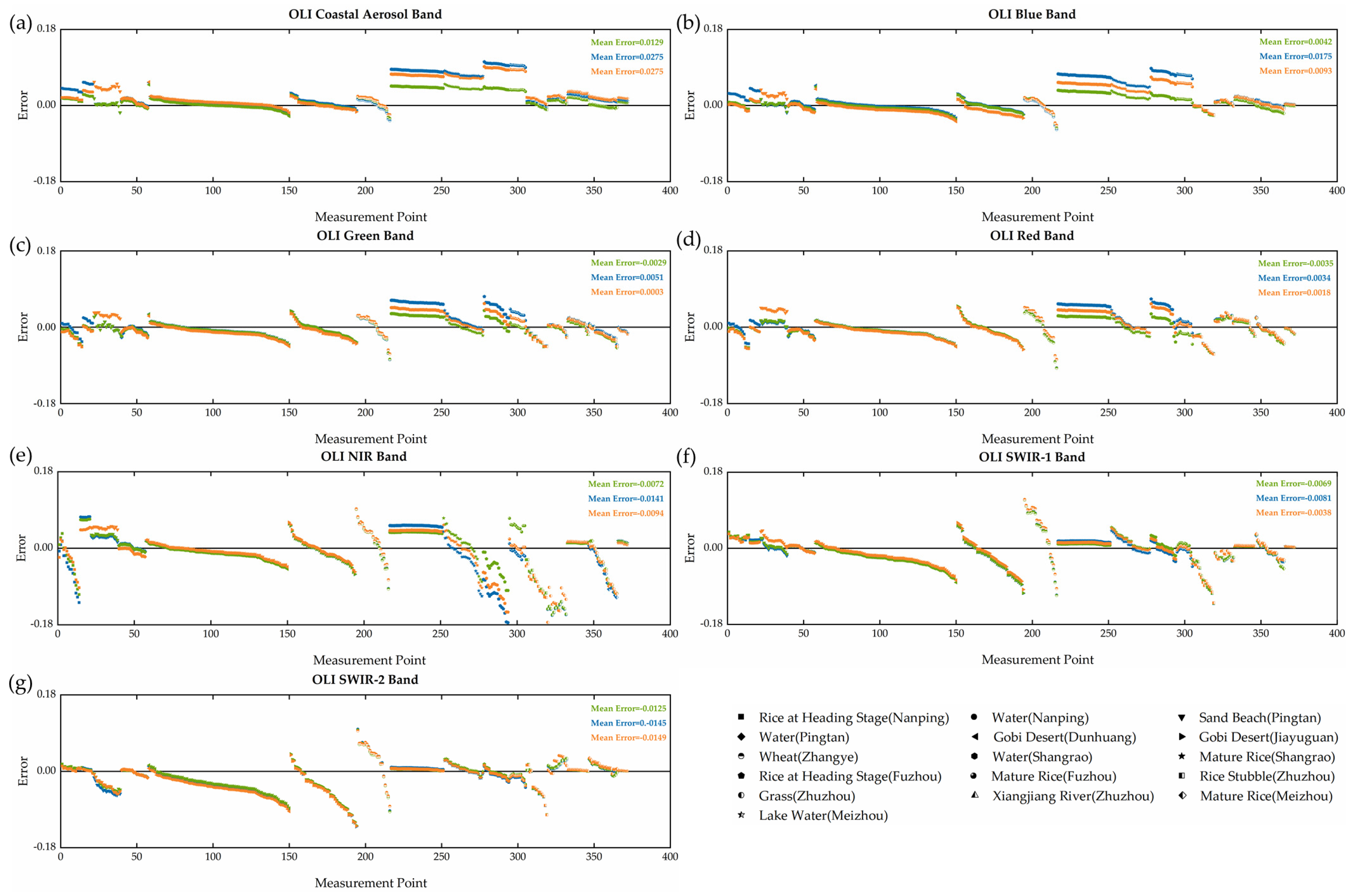


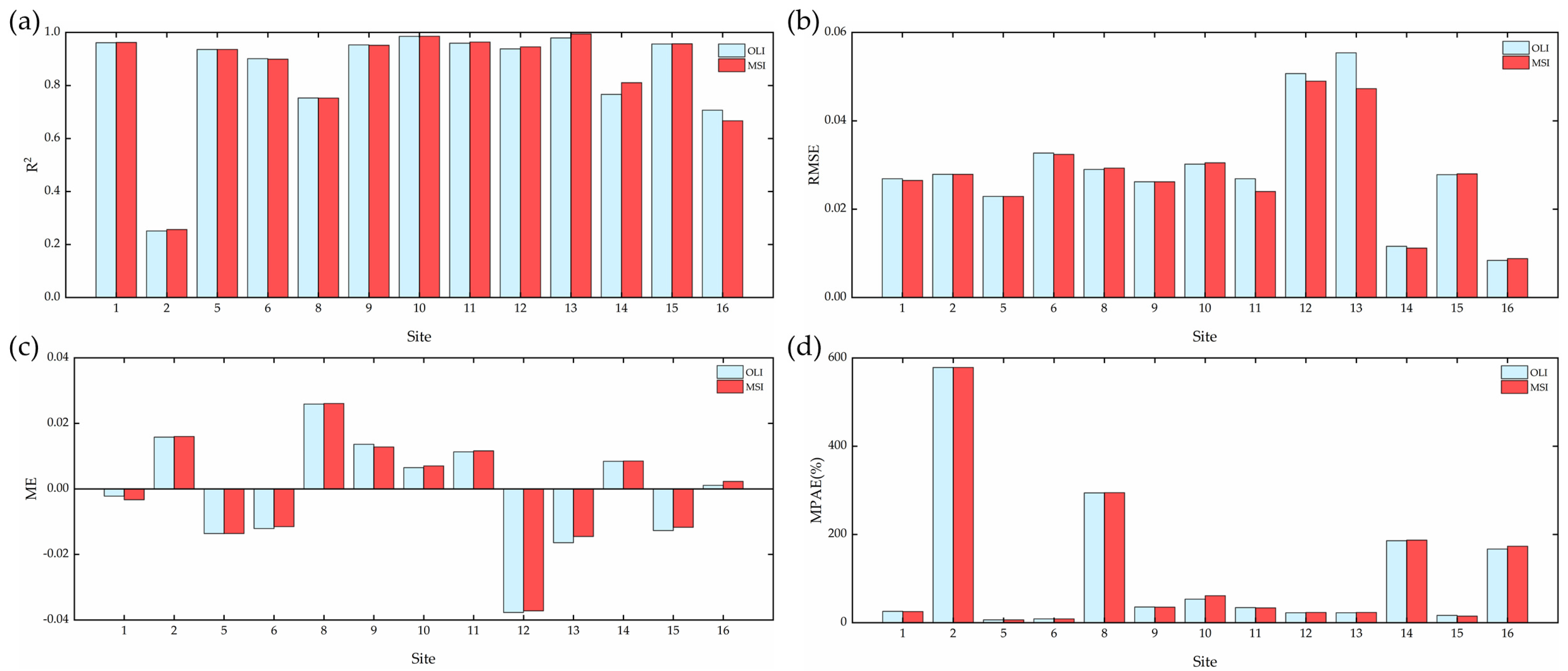
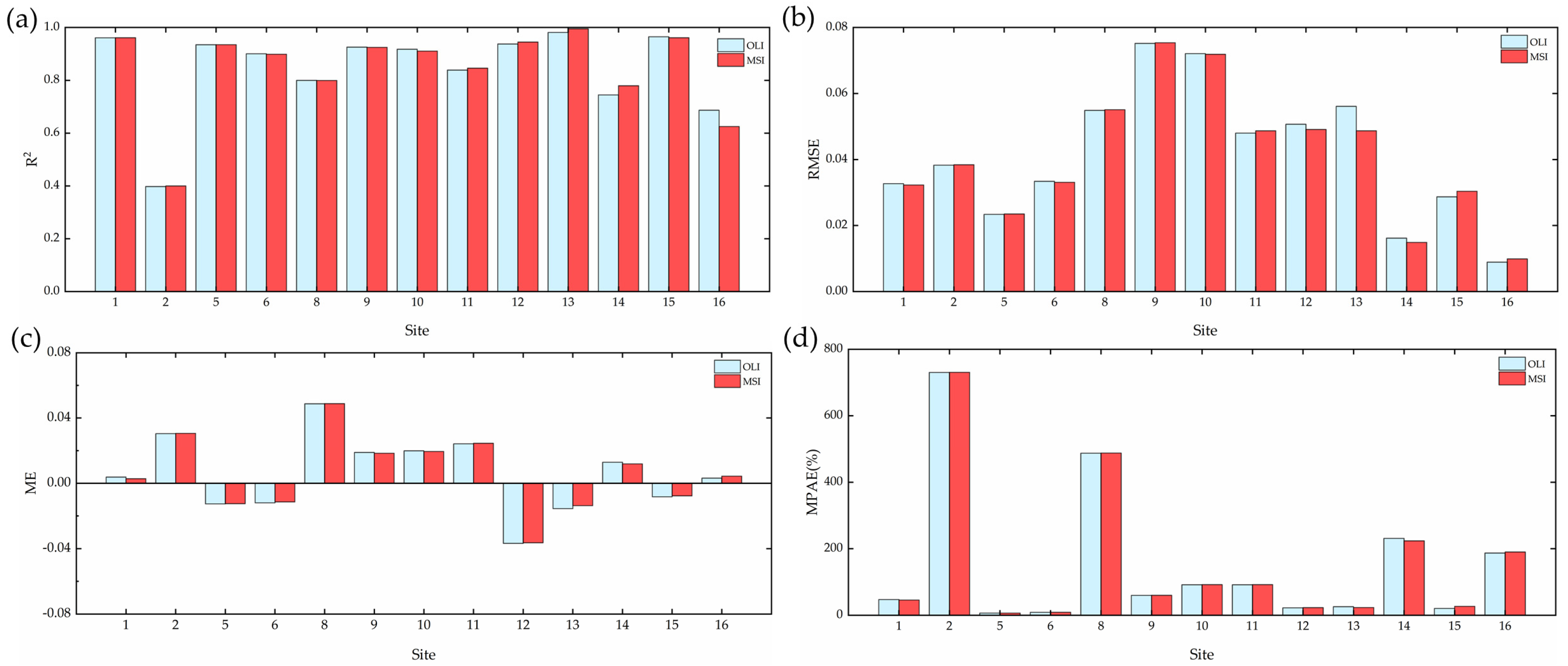

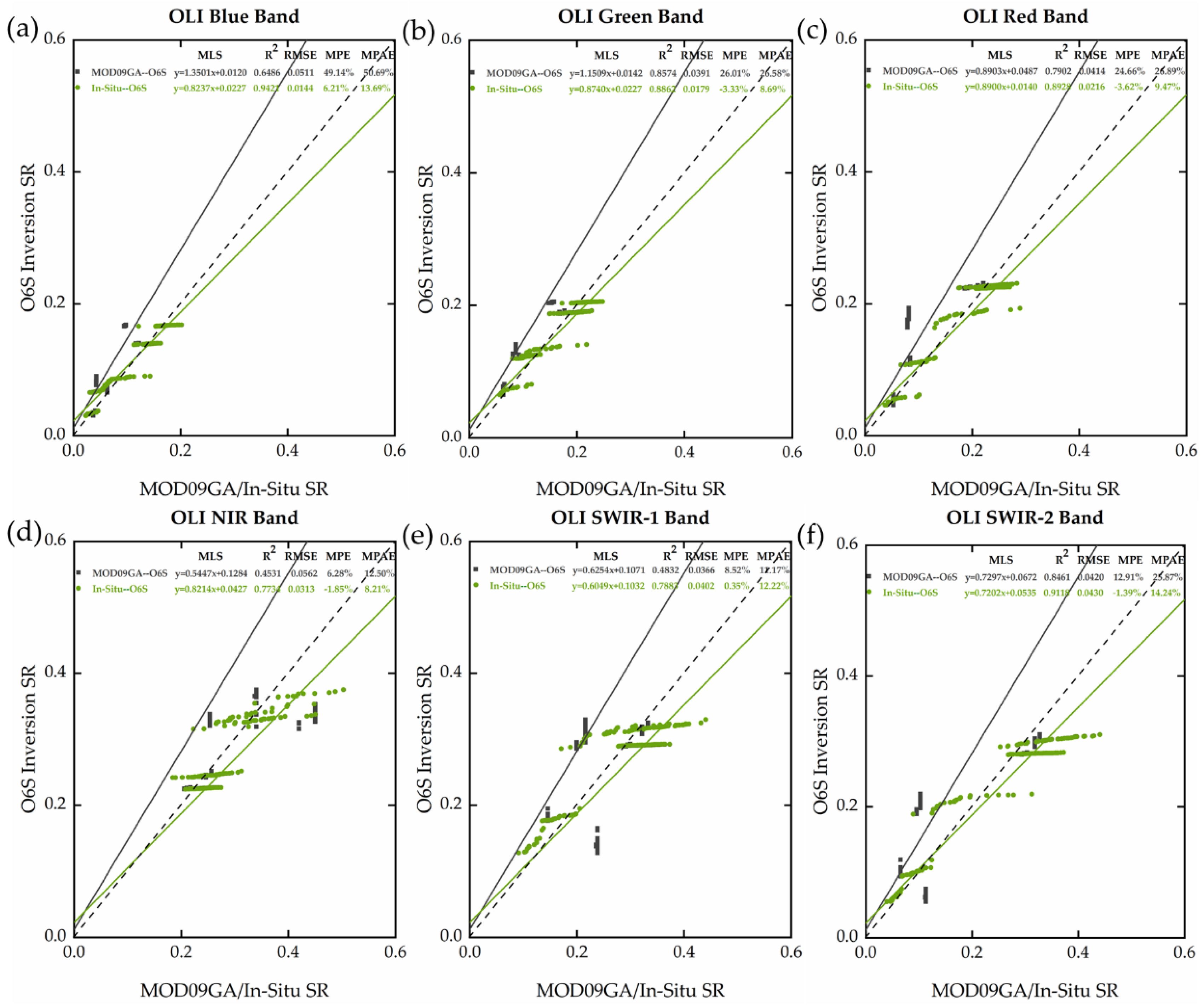



| Site of Samples | City/ Province | Overpass Time | Cloud Cover (%) | Measured Time | ||
|---|---|---|---|---|---|---|
| Code | Land Type | Landsat-8 | Sentinel-2 | |||
| 1 | Rice at Heading Stage | Nanping/ Fujian | 10: 38/13/09 | 10: 35/11/09 | 24.51/21.03 | 10: 12–10: 57/13/09 |
| 2 | Water | 14: 02–14: 15/13/09 | ||||
| 3 | Sand Beach | Pingtan/ Fujian | 10: 26/15/09 | no data | 17.46/no | 10: 17–10: 37/15/09 |
| 4 | Water | 12: 22–12: 43/15/09 | ||||
| 5 | Gobi Desert | Dunhuang/ Gansu | 12: 20/20/09 | 12: 27/20/09 | 0.46/1.08 | 11: 12–13: 45/20/09 |
| 6 | Gobi Desert | 12: 07/22/09 | 12: 15/21/09 | 2.28/80.34 | 11: 50–12: 58/22/09 | |
| 7 | Wheat | Zhangye/ Gansu | 11: 56/24/09 | no data | 4.87/no | 11: 49–12: 20/24/09 |
| 8 | Water | Shangrao/ Jiangxi | 10: 38/29/09 | 10: 45/29/09 | 1.97/1.33 | 10: 35–11: 08/29/09 |
| 9 | Mature Rice | 12: 27–12: 55/29/09 | ||||
| 10 | Rice at Heading Stage | Fuzhou/ Jiangxi | 10: 44/06/10 | 10: 45/04/10 | 44.65/0.31 | 12: 13–12: 38/06/10 |
| 11 | Mature Rice | 12: 40–12: 54/06/10 | ||||
| 12 | Rice Stubble | Zhuzhou/ Hunan | 10: 56/20/10 | 11: 07/20/10 | 5.37/6.00 | 10: 48–11: 09/20/10 |
| 13 | Grass | 11: 11–11: 22/20/10 | ||||
| 14 | Xiangjiang River | 13: 12–13: 38/20/10 | ||||
| 15 | Mature Rice | Meizhou/ Guangdong | 10: 45/22/10 | 10: 47/19/10 | 9.40/5.03 | 10: 28–10: 59/22/10 |
| 16 | Lake Water | 12: 47–13: 12/22/10 | ||||
| Landsat-8 OLI | Sentinel-2 MSI | ||||
|---|---|---|---|---|---|
| Band | Resolution (m) | Wavelength (nm) | Band | Resolution (m) | Wavelength (nm) |
| B1 (Coastal) | 30 | 430–450 | B1 (Coastal) | 60 | 433–453 |
| B2 (Blue) | 30 | 450–515 | B2 (Blue) | 10 | 458–523 |
| B3 (Green) | 30 | 525–600 | B3 (Green) | 10 | 543–578 |
| B4 (Red) | 30 | 630–680 | B4 (Red) | 10 | 650–680 |
| B5 (NIR) | 30 | 845–885 | B8 (NIR) | 10 | 785–900 |
| B6 (SWIR-1) | 30 | 1560–1660 | B11 (SWIR-1) | 20 | 1565–1655 |
| B7 (SWIR-2) | 30 | 2100–2300 | B12(SWIR-2) | 20 | 2100–2280 |
| Site | Statistics | Coastal | Blue | Green | Red | NIR | SWIR-1 | SWIR-2 | |
|---|---|---|---|---|---|---|---|---|---|
| 1 | Rice at Heading Stage (Nanping) | RMSE | 0.0412 | 0.0058 | 0.0230 | 0.0249 | 0.0528 | 0.0279 | 0.0097 |
| MPAE (%) | 67.19 | 16.72 | 20.36 | 24.39 | 9.19 | 24.26 | 18.02 | ||
| 2 | Water (Nanping) | RMSE | 0.0234 | 0.0098 | 0.0047 | 0.0069 | 0.0670 | 0.0152 | 0.0042 |
| MPAE (%) | 67.47 | 23.53 | 6.12 | 11.06 | 1385.71 | 4543.20 | 130.68 | ||
| 3 | Sand Beach (Pingtan) | RMSE | 0.0065 | 0.0064 | 0.0112 | 0.0135 | 0.0304 | 0.0103 | 0.0358 |
| MPAE (%) | 2.54 | 2.48 | 2.95 | 3.92 | 8.17 | 1.62 | 7.72 | ||
| 4 | Water (Pingtan) | RMSE | 0.0082 | 0.0064 | 0.0104 | 0.0144 | 0.0067 | 0.0064 | 0.0070 |
| MPAE (%) | 29.75 | 15.76 | 13.91 | 24.85 | 66.51 | 221.51 | 69.84 | ||
| 5 | Gobi Desert (Dunhuang) | RMSE | 0.0098 | 0.0119 | 0.0154 | 0.0164 | 0.0196 | 0.0327 | 0.0384 |
| MPAE (%) | 4.45 | 5.23 | 5.61 | 5.40 | 6.32 | 8.24 | 9.96 | ||
| 6 | Gobi Desert (Jiayuguan) | RMSE | 0.0097 | 0.0114 | 0.0179 | 0.0232 | 0.0271 | 0.0457 | 0.0600 |
| MPAE (%) | 6.24 | 6.64 | 7.47 | 7.93 | 8.77 | 10.49 | 13.31 | ||
| 7 | Wheat (Zhangye) | RMSE | 0.0151 | 0.0196 | 0.0278 | 0.0373 | 0.0474 | 0.0691 | 0.0544 |
| MPAE (%) | 24.09 | 18.24 | 16.45 | 16.63 | 13.67 | 25.75 | 32.27 | ||
| 8 | Water (Shangrao) | RMSE | 0.0438 | 0.0326 | 0.0278 | 0.0246 | 0.0378 | 0.0100 | 0.0050 |
| MPAE (%) | 174.27 | 126.03 | 95.37 | 143.32 | 687.09 | 590.91 | 241.87 | ||
| 9 | Mature Rice (Shangrao) | RMSE | 0.0117 | 0.0049 | 0.0018 | 0.0026 | 0.0104 | 0.0054 | 0.0027 |
| MPAE (%) | 142.70 | 50.37 | 8.87 | 12.51 | 8.87 | 11.50 | 13.86 | ||
| 10 | Rice at Heading Stage (Fuzhou) | RMSE | 0.0403 | 0.0218 | 0.0194 | 0.0218 | 0.0557 | 0.0156 | 0.0097 |
| MPAE (%) | 188.46 | 78.28 | 26.60 | 50.86 | 10.26 | 8.08 | 10.62 | ||
| 11 | Mature Rice (Fuzhou) | RMSE | 0.0364 | 0.0141 | 0.0062 | 0.0195 | 0.0529 | 0.0125 | 0.0135 |
| MPAE (%) | 142.54 | 37.91 | 5.36 | 19.03 | 15.88 | 6.33 | 11.83 | ||
| 12 | Rice Stubble (Zhuzhou) | RMSE | 0.0056 | 0.0145 | 0.0309 | 0.0424 | 0.0792 | 0.0782 | 0.0508 |
| MPAE (%) | 12.02 | 18.27 | 26.73 | 29.13 | 29.56 | 23.99 | 18.43 | ||
| 13 | Grass (Zhuzhou) | RMSE | 0.0106 | 0.0064 | 0.0083 | 0.0193 | 0.1415 | 0.0222 | 0.0190 |
| MPAE (%) | 35.67 | 19.37 | 6.23 | 50.26 | 25.98 | 7.71 | 13.01 | ||
| 14 | Xiangjiang River (Zhuzhou) | RMSE | 0.0162 | 0.0104 | 0.0097 | 0.0128 | 0.0115 | 0.0041 | 0.0023 |
| MPAE (%) | 70.25 | 36.07 | 21.52 | 72.41 | 601.06 | 308.24 | 156.44 | ||
| 15 | Mature Rice (Meizhou) | RMSE | 0.0036 | 0.108 | 0.0227 | 0.0215 | 0.0599 | 0.0233 | 0.0137 |
| MPAE (%) | 11.76 | 24.22 | 18.90 | 18.03 | 13.08 | 11.07 | 18.71 | ||
| 16 | Lake Water (Meizhou) | RMSE | 0.0070 | 0.0009 | 0.0105 | 0.0098 | 0.0150 | 0.0034 | 0.0013 |
| MPAE (%) | 36.28 | 3.22 | 22.26 | 29.40 | 442.23 | 530.07 | 104.85 | ||
| Site | Statistics | Coastal | Blue | Green | Red | NIR | SWIR-1 | SWIR-2 | |
|---|---|---|---|---|---|---|---|---|---|
| 1 | Rice at Heading Stage (Nanping) | RMSE | 0.0177 | 0.0075 | 0.0151 | 0.0152 | 0.0593 | 0.0615 | 0.0299 |
| MPAE (%) | 83.30 | 20.68 | 11.55 | 15.84 | 11.86 | 52.28 | 53.75 | ||
| 2 | Water (Nanping) | RMSE | 0.0043 | 0.0050 | 0.0133 | 0.0148 | 0.0408 | 0.0175 | 0.0069 |
| MPAE (%) | 11.81 | 9.64 | 18.26 | 31.09 | 478.61 | 5258.24 | 201.72 | ||
| 5 | Gobi Desert (Dunhuang) | RMSE | 0.0196 | 0.0130 | 0.0119 | 0.0132 | 0.0132 | 0.0179 | 0.0205 |
| MPAE (%) | 11.69 | 6.21 | 4.15 | 4.53 | 4.02 | 4.33 | 5.06 | ||
| 6 | Gobi Desert (Jiayuguan) | RMSE | 0.0486 | 0.0341 | 0.0241 | 0.0255 | 0.0281 | 0.0659 | 0.0741 |
| MPAE (%) | 39.64 | 23.28 | 11.29 | 9.35 | 9.48 | 15.53 | 16.83 | ||
| 8 | Water (Shangrao) | RMSE | 0.0293 | 0.0260 | 0.0210 | 0.0222 | 0.0333 | 0.0129 | 0.0079 |
| MPAE (%) | 116.70 | 98.81 | 70.63 | 137.45 | 526.82 | 747.20 | 371.62 | ||
| 9 | Mature Rice (Shangrao) | RMSE | 0.0216 | 0.0094 | 0.0199 | 0.0154 | 0.0486 | 0.0224 | 0.0149 |
| MPAE (%) | 74.45 | 15.62 | 14.84 | 14.28 | 10.73 | 10.69 | 14.19 | ||
| 10 | Rice at Heading Stage (Fuzhou) | RMSE | 0.0125 | 0.0067 | 0.0174 | 0.0145 | 0.1214 | 0.0076 | 0.0063 |
| MPAE (%) | 58.99 | 19.99 | 17.23 | 28.95 | 26.05 | 4.49 | 8.14 | ||
| 11 | Mature Rice (Fuzhou) | RMSE | 0.0078 | 0.0040 | 0.0225 | 0.0296 | 0.0160 | 0.0104 | 0.0065 |
| MPAE (%) | 30.36 | 6.69 | 23.59 | 33.65 | 4.16 | 4.80 | 4.92 | ||
| 12 | Rice Stubble (Zhuzhou) | RMSE | 0.0084 | 0.0211 | 0.0406 | 0.0501 | 0.0863 | 0.0732 | 0.0463 |
| MPAE (%) | 13.47 | 30.35 | 39.22 | 37.09 | 35.90 | 22.96 | 18.97 | ||
| 13 | Grass (Zhuzhou) | RMSE | 0.0082 | 0.0059 | 0.0202 | 0.0071 | 0.1145 | 0.0246 | 0.0058 |
| MPAE (%) | 27.31 | 7.80 | 21.91 | 16.73 | 20.98 | 7.68 | 3.88 | ||
| 14 | Xiangjiang River (Zhuzhou) | RMSE | 0.0205 | 0.0136 | 0.0087 | 0.0120 | 0.0209 | 0.0139 | 0.0120 |
| MPAE (%) | 88.09 | 45.24 | 20.00 | 79.40 | 672.13 | 972.61 | 694.92 | ||
| 15 | Mature Rice (Meizhou) | RMSE | 0.0061 | 0.0072 | 0.0282 | 0.0258 | 0.0727 | 0.0236 | 0.0161 |
| MPAE (%) | 23.90 | 12.78 | 25.29 | 22.85 | 18.02 | 11.72 | 14.88 | ||
| 16 | Lake Water (Meizhou) | RMSE | 0.0079 | 0.0011 | 0.0148 | 0.0101 | 0.0234 | 0.0063 | 0.0025 |
| MPAE (%) | 43.81 | 6.43 | 30.47 | 33.91 | 1030.98 | 938.79 | 206.05 | ||
| Site | Statistics | Optimized 6S | 6S | FLAASH | |
|---|---|---|---|---|---|
| OLI/MSI | OLI/MSI | OLI/MSI | |||
| 1 | Rice at Heading Stage (Nanping) | R2 | 0.9612/0.9625 | 0.9610/0.9613 | 0.9673/0.9615 |
| RMSE | 0.0269/0.0265 | 0.0327/0.0323 | 0.0246/0.0259 | ||
| ME | −0.0022/−0.0033 | 0.0038/0.0028 | −0.0039/−0.0022 | ||
| MPAE (%) | 25.73/25.21 | 47.15/45.91 | 26.93/29.41 | ||
| 2 | Water (Nanping) | R2 | 0.02513/0.02567 | 0.3978/0.4000 | 0.4826/0.4909 |
| RMSE | 0.0279/0.0279 | 0.0383/0.0384 | 0.0224/0.0227/ | ||
| ME | 0.0158/0.0160 | 0.0304/0.0306 | 0.0135/0.0139 | ||
| MPAE (%) | 578.47/578.69 | 730.53/730.96 | 450.14/430.51 | ||
| 5 | Gobi (Dunhuang) | R2 | 0.9358/0.9361 | 0.9347/0.9350 | 0.9217/0.9203 |
| RMSE | 0.0229/0.0229 | 0.0234/0.0235 | 0.0242/0.0242 | ||
| ME | −0.0136/−0.0136 | −0.0126/−0.0125 | −0.0138/−0.0138 | ||
| MPAE (%) | 6.46/6.48 | 6.57/6.60/9.33 | 7.09/7.14/8.56 | ||
| 6 | Gobi (Jiayuguan) | R2 | 0.9011/0.8992 | 0.9007/0.8989 | 0.8940/0.8884 |
| RMSE | 0.0327/0.0324 | 0.0334/0.0331 | 0.0330/0.0336 | ||
| ME | −0.0121/−0.0115 | −0.0120/−0.0114 | −0.0140/−0.0122 | ||
| MPAE | 8.69/8.71 | 8.90/8.92 | 9.26/9.33% | ||
| 8 | Mature Rice (Shangrao) | R2 | 0.9532/0.9518 | 0.9259/0.9249 | 0.9360/0.9361 |
| RMSE | 0.0262/0.0262 | 0.0752/0.0754 | 0.0345/0.0344 | ||
| ME | 0.0136/0.0128 | 0.0189/0.0184 | 0.0190/0.0183 | ||
| MPAE (%) | 35.53/35.25 | 59.86/60.10 | 52.26/52.21 | ||
| 9 | Water (Shangrao) | R2 | 0.7527/0.7525 | 0.7999/0.7995 | 0.7755/0.7747 |
| RMSE | 0.0290/0.0293 | 0.0549/0.0551 | 0.0430/0.0427 | ||
| ME | 0.0259/0.0261 | 0.0487/0.0488 | 0.0376/0.0372 | ||
| MPAE (%) | 294.12/294.72 | 487.22/487.70 | 378.69/372.06 | ||
| 10 | Rice at Heading Stage (Fuzhou) | R2 | 0.9853/0.9860 | 0.9119/0.9107 | 0.9463/0.9443 |
| RMSE | 0.0302/0.0305 | 0.0721/0.0719 | 0.0595/0.0602 | ||
| ME | 0.0065/0.0070 | 0.0199/0.0195 | 0.0157/0.0162 | ||
| MPAE (%) | 53.31/61.12 | 140.77/140.61 | 115.74/129.29 | ||
| 11 | Mature Rice (Fuzhou) | R2 | 0.9596/0.9640 | 0.8389/0.8462 | 0.8896/0.8963 |
| RMSE | 0.0269/0.0240 | 0.0480/0.0487 | 0.0391/0.0396 | ||
| ME | 0.0113/0.0116 | 0.0242/0.0245 | 0.0202/0.0205 | ||
| MPAE (%) | 34.13/33.46 | 91.57/92.12 | 74.01/75.13 | ||
| 12 | Rice Stubble (Zhuzhou) | R2 | 0.9382/0.9458 | 0.9376/0.9449 | 0.9290/0.9310 |
| RMSE | 0.0507/0.0490 | 0.0507/0.0491 | 0.0520/0.0487 | ||
| ME | −0.0377/−0.0372 | −0.0368/−0.0364 | −0.0367/−0.0378 | ||
| MPAE (%) | 22.59/23.26 | 22.32/23.04 | 25.73/25.82 | ||
| 13 | Grass (Zhuzhou) | R2 | 0.9793/0.9945 | 0.9815/0.9951 | 0.9780/0.9943 |
| RMSE | 0.0554/0.0473 | 0.0561/0.0487 | 0.0509/0.0367 | ||
| ME | −0.0164/−0.0145 | −0.0155/−0.0137 | −0.0105/−0.0110 | ||
| MPAE (%) | 22.60/23.23 | 25.79/23.23 | 29.39/18.34 | ||
| 14 | Xiangjiang River (Zhuzhou) | R2 | 0.7665/0.8107 | 0.7445/0.7797 | 0.6766/0.7750 |
| RMSE | 0.0116/0.0112 | 0.0162/0.0149 | 0.0190/0.0092 | ||
| ME | 0.0084/0.00853 | 0.0129/0.0119 | 0.0148/0.0050 | ||
| MPAE (%) | 185.74/187.11 | 231.21/223.72 | 248.95/132.32 | ||
| 15 | Mature Rice (Meizhou) | R2 | 0.9566/0.9574 | 0.9649/0.9612 | 0.9604/0.9576 |
| RMSE | 0.0278/0.0280 | 0.0287/0.0304 | 0.0273/0.0292 | ||
| ME | −0.0127/−0.0117 | −0.0083/−0.0077 | −0.0070/−0.0054 | ||
| MPAE (%) | 16.54/14.92 | 20.60/26.96 | 22.58/30.93 | ||
| 16 | Lake Water (Meizhou) | R2 | 0.7068/0.6667 | 0.6868/0.6248 | 0.6305/0.5237 |
| RMSE | 0.0084/0.0088 | 0.0089/0.0099 | 0.0094/0.0116 | ||
| ME | 0.0011/0.0023 | 0.0032/0.0044 | 0.0028/0.0050 | ||
| MPAE (%) | 166.90/173.46 | 187.11/190.28 | 167.75/176.88 | ||
| Sensor | Method | Band | Slope | R2 | RMSE | MPE (%) | MPAE (%) |
|---|---|---|---|---|---|---|---|
| MO09GA SR/In Situ SR—Reflectance Inversion Values | |||||||
| OLI | O6S | Blue | 1.3501/0.8237 | 0.6468/0.9421 | 0.0511/0.0144 | 49.14/6.21 | 50.69/13.69 |
| Green | 1.1509/0.8740 | 0.8574/0.8862 | 0.0391/0.0179 | 26.01/−3.33 | 26.58/8.69 | ||
| Red | 0.8903/0.8928 | 0.7902/0.8928 | 0.0414/0.0216 | 24.66/−3.62 | 26.89/9.47 | ||
| NIR | 0.5447/0.8214 | 0.4531/0.7734 | 0.0562/0.0313 | 6.28/−1.85 | 12.50/8.21 | ||
| SWIR-1 | 0.6254/0.6049 | 0.4832/0.7883 | 0.0366/0.0402 | 8.52/0.35 | 11.17/12.22 | ||
| SWIR-2 | 0.7297/0.7202 | 0.8461/0.9118 | 0.0420/0.0430 | 12.91/−1.39 | 25.87/14.24 | ||
| 6S | Blue | 1.1937/0.6959 | 0.6601/0.8754 | 0.0545/0.0223 | 59.66/6.21 | 59.66/13.69 | |
| Green | 1.0599/0.7986 | 0.8674/0.8824 | 0.0406/0.0178 | 29.32/−0.53 | 29.32/8.67 | ||
| Red | 0.8347/0.8926 | 0.7987/0.8926 | 0.0422/0.0214 | 27.71/−0.94 | 28.06/9.11 | ||
| NIR | 0.5311/0.6953 | 0.5907/0.7601 | 0.0476/0.0338 | 4.35/−3.26 | 10.66/8.23 | ||
| SWIR-1 | 0.6658/0.6303 | 0.5025/0.7851 | 0.0354/0.0399 | 7.61/−0.53 | 10.39/11.86 | ||
| SWIR-2 | 0.7257/0.7184 | 0.8366/0.9070 | 0.0429/0.0446 | 11.45/−2.73 | 25.92/14.32 | ||
| FLAASH | Blue | 1.1768/0.7343 | 0.5907/0.8975 | 0.0479/0.0196 | 47.35/6.77 | 50.45/19.37 | |
| Green | 1.0643/0.8203 | 0.8245/0.8777 | 0.0378/0.0193 | 25.47/−3.81 | 26.76/9.93 | ||
| Red | 0.8250/0.8522 | 0.7354/0.8871 | 0.0439/0.0220 | 26.41/−2.77 | 29.20/10.12 | ||
| NIR | 0.5552/0.7938 | 0.5234/0.8032 | 0.0522/0.0287 | 6.97/−1.05 | 12.54/7.32 | ||
| SWIR-1 | 0.6639/0.6468 | 0.4749/0.7856 | 0.0386/0.0383 | 10.08/1.42 | 10.60/11.35 | ||
| SWIR-2 | 0.7111/0.7085 | 0.8258/0.9071 | 0.0443/0.0463 | 10.84/−3.56 | 27.04/14.67 | ||
| MSI | O6S | Blue | 2.0817/0.9951 | 0.7918/0.9310 | 0.0707/0.0199 | 60.74/11.93 | 62.24/12.98 |
| Green | 1.5039/1.0477 | 0.9482/0.8945 | 0.0474/0.0172 | 28.07/0.43 | 28.09/8.08 | ||
| Red | 1.2840/1.0231 | 0.9887/0.9414 | 0.0389/0.0175 | 18.47/2.14 | 19.54/8.06 | ||
| NIR | 0.9767/0.5701 | 0.9079/0.8213 | 0.0295/0.0302 | 11.76/−0.87 | 11.76/6.98 | ||
| SWIR-1 | 0.7447/0.5996 | 0.6790/0.7802 | 0.0292/0.0403 | 6.40/2.35 | 12.03/11.84 | ||
| SWIR-2 | 0.8822/0.7654 | 0.9271/0.8812 | 0.0260/0.0411 | 6.27/1.53 | 15.49/13.18 | ||
| 6S | Blue | 1.2760/0.8209 | 0.4275/0.9102 | 0.0663/0.0188 | 61.24/15.34 | 61.24/19.38 | |
| Green | 1.0929/0.9075 | 0.6495/0.8705 | 0.0440/0.0181 | 24.96/−2.60 | 26.00/8.02 | ||
| Red | 1.0403/0.8761 | 0.8340/0.8869 | 0.0358/0.0227 | 15.85/−0.24 | 18.69/9.72 | ||
| NIR | 0.7496/0.5351 | 0.5655/0.7654 | 0.0275/0.0394 | 5.35/−6.92 | 11.60/9.09 | ||
| SWIR-1 | 0.6131/0.5113 | 0.3896/0.4802 | 0.0479/0.0596 | 1.34/−2.17 | 15.51/14.91 | ||
| SWIR-2 | 0.8020/0.6900 | 0.7779/0.7272 | 0.0463/0.0618 | 1.30/−3.09 | 18.61/16.19 | ||
| FLAASH | Blue | 1.7863/0.8680 | 0.7775/0.9445 | 0.0748/0.0253 | 72.67/24.15 | 72.67/24.42 | |
| Green | 1.4002/0.9890 | 0.9409/0.9127 | 0.0547/0.0181 | 35.81/6.54 | 35.81/8.79 | ||
| Red | 1.2407/0.9920 | 0.9858/0.9450 | 0.0453/0.0200 | 24.68/7.64 | 24.98/9.92 | ||
| NIR | 1.0871/0.6163 | 0.9395/0.8016 | 0.0409/0.0292 | 16.83/3.66 | 16.83/8.11 | ||
| SWIR-1 | 0.8751/0.6553 | 0.7562/0.7517 | 0.0356/0.0413 | 11.44/8.42 | 13.96/14.41 | ||
| SWIR-2 | 0.9175/0.7880 | 0.9325/0.8687 | 0.0256/0.0403 | 7.53/4.06 | 14.58/14.71 | ||
Publisher’s Note: MDPI stays neutral with regard to jurisdictional claims in published maps and institutional affiliations. |
© 2021 by the authors. Licensee MDPI, Basel, Switzerland. This article is an open access article distributed under the terms and conditions of the Creative Commons Attribution (CC BY) license (https://creativecommons.org/licenses/by/4.0/).
Share and Cite
Zhou, X.; Liu, X.; Wang, X.; He, G.; Zhang, Y.; Wang, G.; Zhang, Z. Evaluation of Surface Reflectance Products Based on Optimized 6S Model Using Synchronous In Situ Measurements. Remote Sens. 2022, 14, 83. https://doi.org/10.3390/rs14010083
Zhou X, Liu X, Wang X, He G, Zhang Y, Wang G, Zhang Z. Evaluation of Surface Reflectance Products Based on Optimized 6S Model Using Synchronous In Situ Measurements. Remote Sensing. 2022; 14(1):83. https://doi.org/10.3390/rs14010083
Chicago/Turabian StyleZhou, Xiaocheng, Xueping Liu, Xiaoqin Wang, Guojin He, Youshui Zhang, Guizhou Wang, and Zhaoming Zhang. 2022. "Evaluation of Surface Reflectance Products Based on Optimized 6S Model Using Synchronous In Situ Measurements" Remote Sensing 14, no. 1: 83. https://doi.org/10.3390/rs14010083
APA StyleZhou, X., Liu, X., Wang, X., He, G., Zhang, Y., Wang, G., & Zhang, Z. (2022). Evaluation of Surface Reflectance Products Based on Optimized 6S Model Using Synchronous In Situ Measurements. Remote Sensing, 14(1), 83. https://doi.org/10.3390/rs14010083







